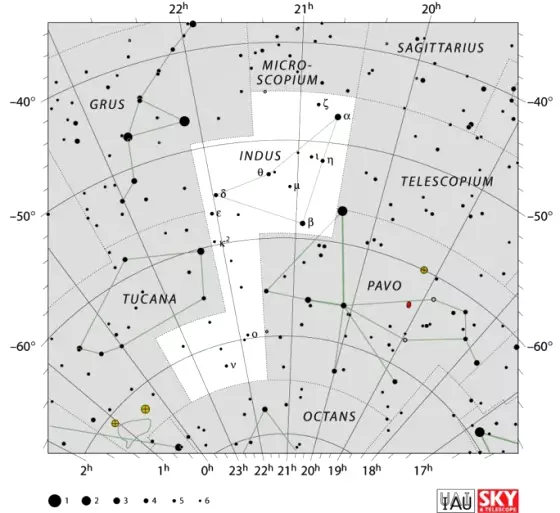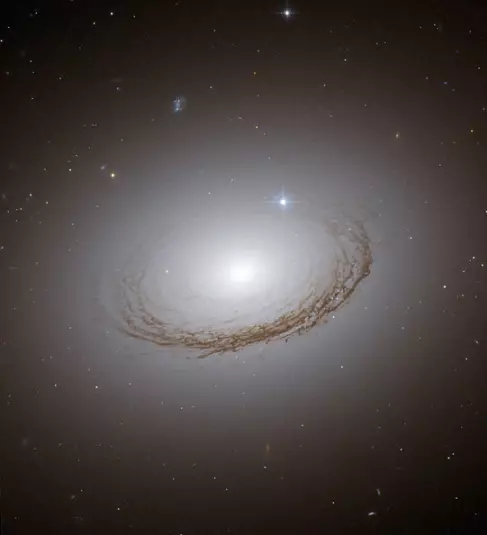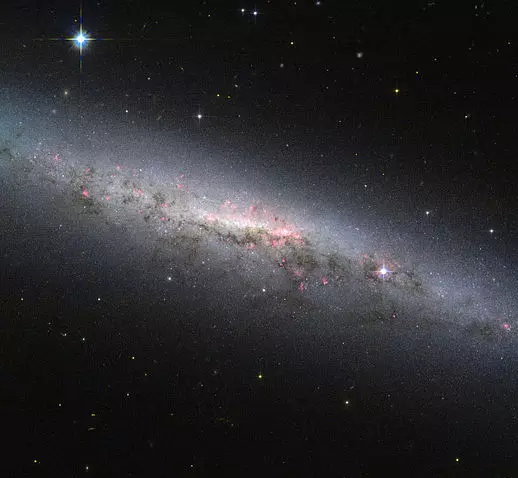Indus constellation is located in the southern hemisphere. It does not contain any bright stars. The constellation represents the Indian, referring to a native of either of Asia or the Americas at the time the constellation was created.
The constellation was created by the Dutch astronomer Petrus Plancius in the late 16th century and first depicted in a star atlas in Johann Bayer’s Uranometria atlas in 1603. Plancius depicted Indus as a man holding arrows in both hands. Indus is a relatively dim constellation. Its brightest stars are only of third magnitude. The constellation contains several notable galaxies, including NGC 7049, NGC 7064, NGC 7083, NGC 7090, and IC 5152.
Facts, location and map
Indus is the 49th constellation in size, occupying an area of 294 square degrees. It lies in the fourth quadrant of the southern hemisphere (SQ4) and can be seen at latitudes between +15° and -90°. The neighboring constellations are Grus, Microscopium, Octans, Pavo, Sagittarius, Telescopium and Tucana.
The constellation name Indus is pronounced /ˈɪndəs/. In English, the constellation is known as the Indian. The genitive form of Indus, used in star names, is Indi (pronunciation: /ˈɪndaɪ/). The three-letter abbreviation, adopted by the International Astronomical Union (IAU) in 1922, is Ind.
Indus belongs to the Johann Bayer family of constellations, along with Apus, Chamaeleon, Dorado, Grus, Hydrus, Musca, Pavo, Phoenix, Tucana and Volans.
Indus has two stars with known planets and contains no Messier objects. The brightest star in the constellation is The Persian, Alpha Indi, with an apparent magnitude of 3.11. There are no meteor showers associated with the constellation.
Indus contains one named star, Batsũ̀ (LHS 3844).

Indus constellation map by IAU and Sky&Telescope magazine
Story
There are no myths associated with the constellation. The Indian is usually depicted holding arrows or spears as though hunting. The early depictions, including the one in Bayer’s Uranometria, indicate that Indus might represent a native of Madagascar as depicted in an account of Dutch navigators’ first voyage to the East Indies.
However, it is unclear whether the constellation really represents a native of the East Indies, or Madagascar, or South Africa, as the explorers encountered a number of indigenous peoples on their travels.
Indus stars
The Persian – α Indi (Alpha Indi)
Alpha Indi is a star of the spectral type K0 III-IV, one that has evolved away from the main sequence and entered the giant stage of evolution. It has an apparent magnitude of 3.11 and is approximately 98.3 light years distant from the solar system. The star is sometimes also known as The Persian. It has a couple of 12th and 13th magnitude red dwarf companions.
Alpha Indi has twice the Sun’s mass and 12 times the radius. It is estimated to be about a billion years old.
β Indi (Beta Indi)
Beta Indi is a bright giant belonging to the spectral class K1II. It has a visual magnitude of 3.658 and is approximately 600 light years distant. The star has a visual companion with an apparent magnitude of 12.5.
ε Indi (Epsilon Indi)
Epsilon Indi is a main sequence star, a dwarf belonging to the spectral class K5V. It is only 11.83 light years distant from Earth. The star has two companions, brown dwarfs of the spectral type T1V and T6V. The companions were discovered in 2003.
In depictions of the Indus constellation, Epsilon Indi usually marks one of the arrows held by the Indian in his left hand.
Epsilon Indi has the third highest proper motion of any star visible to the unaided eye, and the ninth highest overall. Around the year 2640, the star will move to the constellation Tucana.
θ Indi (Theta Indi)
Theta Indi is a double star, approximately 91 light years distant from the Sun. The two components are fifth and seventh magnitude stars and are easily resolved in a small telescope.
ρ Indi (Rho Indi)
Rho Indi is a yellow subgiant (spectral classification G2.5IV) with an apparent magnitude of 6.064. The star is 86.43 light years distant from the Sun. It is believed to be about 13 billion years old. It will soon end its life as a planetary nebula. A planet, Rho Indi b, was discovered in the star’s orbit in 2002.
T Indi
T Indi is a semi-regular variable star in Indus. It is a red giant with a period of 11 months. It is located approximately 1900 light years from the solar system. The star’s apparent magnitude varies from 7 to 5.
Deep sky objects in Indus
NGC 7049
NGC 7049 is a galaxy located about 100 million light years from Earth. It spans approximately 150,000 light years.
The galaxy has a prominent dust ring and relatively few globular star clusters. It has characteristics of both a spiral galaxy and an elliptical galaxy. The galaxy’s unusual appearance is believed to the result of several recent collisions with other galaxies.
The star seen at the top of the galaxy’s ring is really located in our own galaxy, the Milky Way.

NGC 7049 in the constellation of Indus. NGC 7049’s unusual appearance is largely due to a prominent dust ring seen in silhouette. The opaque ring stands out against the starlight behind it. NGC 7049 seems similar to a smooth elliptical galaxy, but shows few globular star clusters. The bright star at the top of the ring belongs in our own Galaxy. Not visible is an unusual central polar ring of gas circling out of the plane near the galaxy’s center. Since NGC 7049 is the brightest galaxy in its cluster of galaxies, its formation might have been caused by several prominent and recent galaxy collisions. NGC 7049 spans about 150 thousand light years and lies about 100 million light years away toward the constellation of Indus. Image: NASA/ESA/Hubble Space Telescope
IC 5152
IC 5152 is an irregular galaxy in Indus. It was first discovered by the American astronomer DeLisle Stewart in 1908. It is uncertain whether or not the galaxy is an outlying member of the Local Group of galaxies.
IC 5152 is very easy to resolve into stars, but a very bright star located in the foreground makes deep observations difficult.
NGC 7090
NGC 7090 is a spiral galaxy in Indus. It has an apparent magnitude of 10.51 and is about 30 million light years distant. It was discovered by the English astronomer John Herschel on October 4, 1834.

This image portrays a view of the galaxy NGC 7090, as seen by the NASA/ESA Hubble Space Telescope. The galaxy is viewed edge-on from the Earth, meaning we cannot easily see the spiral arms, which are full of young, hot stars. However, a side-on view shows the galaxy’s disc and the bulging central core, where typically a large group of cool old stars are packed in a compact, spheroidal region. In addition, there are two interesting features present in the image that are worth mentioning: First, we are able to distinguish an intricate pattern of pinkish red regions over the whole galaxy. This indicates the presence of clouds of hydrogen gas. These structures trace the location of ongoing star formation, visual confirmation of recent studies that classify NGC 7090 as an actively star-forming galaxy. Second, we observe dust lanes, depicted as dark regions inside the disc of the galaxy. In NGC 7090, these regions are mostly located in lower half of the galaxy, showing an intricate filamentary structure. Looking from the outside in through the whole disc, the light emitted from the bright center of the galaxy is absorbed by the dust, silhouetting the dusty regions against the bright light in the background. Image: ESA/Hubble & NASA, acknowledgement: R. Tugral
NGC 7083
NGC 7083 is a magnitude 12 barred spiral galaxy. It is considered a grand design spiral galaxy. A supernova, SN 2009hm, was observed in the galaxy in 2009.
NGC 7041
NGC 7041 is an elliptical galaxy. It was discovered by John Herschel on July 7, 1834. The galaxy has a visual magnitude of 11.1.
NGC 7064
NGC 7064 is a barred spiral galaxy, also discovered by John Herschel on July 8, 1834. It has an apparent magnitude of 12.2.
NGC 7029
NGC 7029 is a bright elliptical galaxy in Indus. It has an apparent magnitude of 11.7 and is about 36.3 megaparsecs (118.4 million light years) distant. The galaxy was discovered by John Herschel in 1834.
NGC 7140
NGC 7140 is another spiral galaxy in Indus. It was discovered by the British astronomer John Herschel at the Cape of Good Hope in October 1834. The galaxy has a visual magnitude of 11.7 and is approximately 37.4 Mpc (122 million light years) distant from Earth.